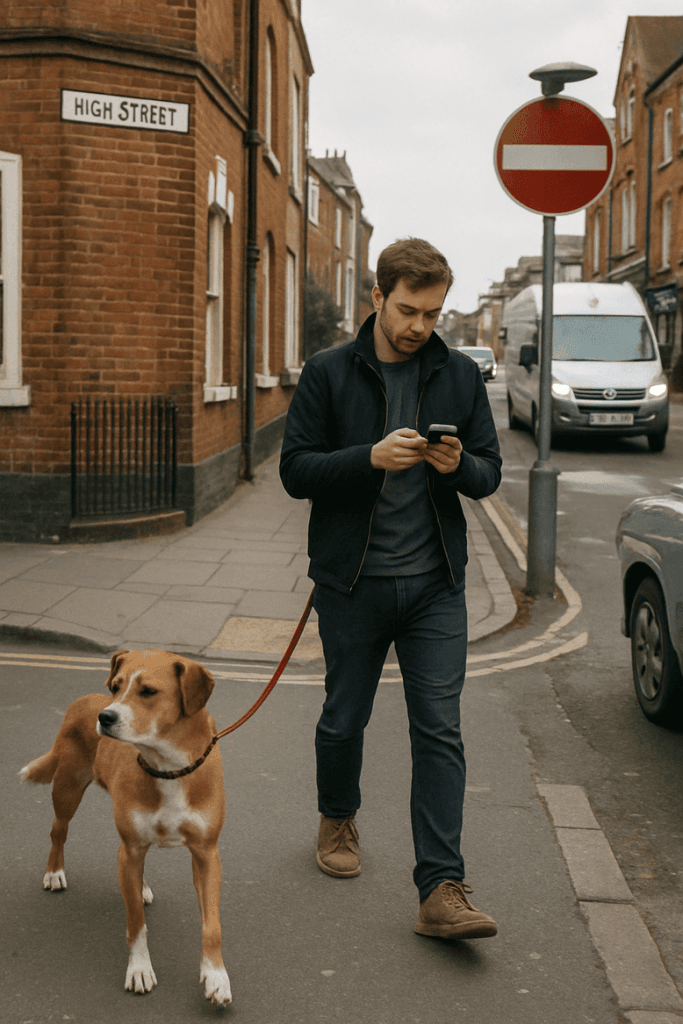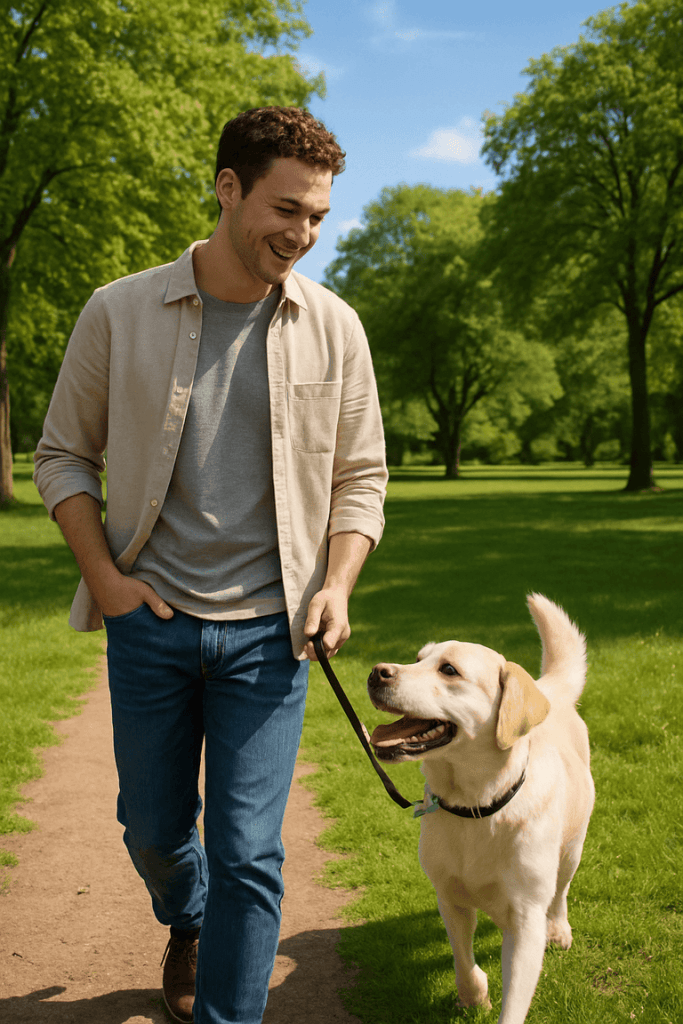Dog walks are an ideal time to strengthen the relationship between the dog and the person, but to get the most benefit, walks must be enriching and interactive. The way a walk is conducted directly affects how much the dog enjoys staying close and how likely they are to pull on the lead. Distractions, such as using a mobile phone, can limit enrichment and training effectiveness, so paying attention and being present is essential for success.
Enrichment Helps Reduce Lead Pulling
Enrichment involves making walks interesting, rewarding, and stimulating for the dog. When a dog finds walking near their person enjoyable because of treats, praise, games, and unpredictable movements, pulling ahead becomes less appealing and loose lead walking is more likely to occur.
- Regularly offer treats and positive reinforcement to reward the dog’s attention and encourage them to stay nearby.
- Use playful changes of pace or direction and include short jogs or sprints, so each walk feels adventurous rather than repetitive.
- Add mini challenges and games, such as weaving around objects, playing tug, or practising tricks, to ensure the walk is engaging for the dog.
- Allow for sniffing and exploration, which provides vital mental stimulation, especially when used as a reward for walking calmly on the lead.

These tactics make walks less predictable and far more rewarding, helping the dog focus on staying close rather than pulling ahead.
Mobile Phones Can Undermine Enrichment
Modern life makes it easy to check a mobile phone while on a dog walk, but this habit can negatively affect the enrichment and training a dog receives.
- Divided attention due to mobile phone use means fewer chances for meaningful engagement, making it harder to notice and reward good behaviour or to play enrichment games.
- Dogs are less likely to get consistent cues, treats, and praise, and important signals, like body language or requests to sniff, may be missed.
- Walks become routine and uninteresting, so the dog might start pulling or searching for excitement elsewhere.
- Important moments for safety and training may go unnoticed if the person is busy with their phone, which can slow progress with lead walking and reduce enjoyment for both.

Focus and Engagement Lead to Better Walks
Choosing to keep the mobile phone away during a walk, only using it for emergencies, allows for genuine connection, greater enjoyment, and more consistent training. Dogs thrive when their person is attentive, responsive, and fully engaged, which builds better habits for calm, close lead walking and makes walks a highlight instead of a chore.

By prioritising enrichment and being present instead of distracted by digital devices, dog walks become memorable experiences and pulling on the lead is much less likely to occur.
Real-Life Scenario
A young couple added a golden retriever puppy to their household and, initially, their lives were filled with joy and happiness, enjoying the enthusiasm of this new addition. However, it wasn’t long before the dog turning into an adolescent dog changed things. Almost overnight, their dog had become a circa 30kg pulling machine and with such a low centre of gravity, the dog’s pulling power (traction force) was circa 60 kg. Now, with the woman only weighing 55kg, her being able to walk the dog became an impossibility so that only the male being able to carry out these tasks. However, even for the man being faced with multiple 45-60 min walks which involved a constant tug of war, mixed in with several lunges (likened to having to (repeatedly) suddenly catch/stop a falling medium-sized (14kg) suitcase).
Consequently, they desperately invested in every ‘miracle’ tool that they could think of, e.g.,
- No pull harness.
- Check chains.
- Belt harness.
- Prong collars.
Initially, after the introduction of these tools, they would see a reduction in the pulling, but it would be short lived. After a short while, their dog would resort to their old ways.
They turned to the wealth of information made available them on social media but, frustratingly, much of the advice did not deliver a consistent message and became confusing. Now, imagine, if it was confusing to the owners, how this would have been received by the dog?
Consequently, much like the adolescent age rescue dogs (25-50%), despite caring deeply for the dog, the couple were starting to think that giving up the dog was likely to be their only option.
Fortunately, before they needed to make this choice, I was able to give them another choice:
To communicate to their dog that being in close proximity (not pulling) is much more fun than being at the full extent of the lead – completely oblivious and independent of the human at the other end of the lead.
Now, don’t get me wrong, the improvements did not happen overnight, and the owners needed to dedicate a lot of time and effort to learn new ways for effectively, and consistently, communicating with their dog. Of course, if the owners stopped effectively communicating with their dog, it would lapse into its old ways. However, with only a flat collar, they now had the knowledge of how to properly use the most effective tools (themselves) to deter their dog from pulling throughout their walks.
Consequently, it wasn’t too long before the walks became more enjoyable, and the woman could confidently enjoy taking her dog for a walk.
Further Reading on Adolescent Dogs and Pulling
Understanding Adolescent Dog Behaviours
- “Adolescence is ruff on dogs too” .
- Explores behavioural changes in teenage dogs and their impact on rehoming and owner challenges.
- “Post-Adoption Problem Behaviours in Adolescent and Adult Dogs”.
- Research on common behavioural issues displayed by adolescent rescue dogs after adoption.
Dog Pulling Force and Physical Impact
- “An Investigation of Force Potential Against the Companion Dog Neck Associated with Collar Use”.
- Scientific analysis of the forces exerted by dogs on a lead, including adolescent dogs and the effects on handlers and equipment.
- “Effects of Restraint by a Neck Collar vs. a Chest Harness”.
- Comparative study investigating lead pulling with different restraints and their implications for dogs’ welfare.
Reducing Lead Pulling: Training, Enrichment, and Human Behaviours
- “Adolescence in Dogs” (Blue Cross).
- Guidance for managing youthful exuberance and improving lead manners in adolescent dogs.
- “Learn to Adore Your Adolescent Dog”.
- Book and resources on practical techniques for surviving and thriving with teenage dogs.
Canine Enrichment and Engagement
- “Applications of Newton’s Laws of Motion in Daily Life”.
- Provides context on real-life force and pressure examples, helpful for visualizing pulling forces.
- “My Dog Wants To Greet Everyone While On A Walk!”.
- Discussion of lead-pulling motivations and owner engagement techniques.
Scientific and Practical Guides
- “Dogs Trust Ireland – Teenage Dogs are at Highest Risk of Being Surrendered”.
- Explains why adolescent dogs make up a large percentage of shelter animals and what owners can do.
- “Golden Retriever Growth & Weight Chart”.
- Reference for understanding growth, weight, and strength development in adolescent retrievers.

